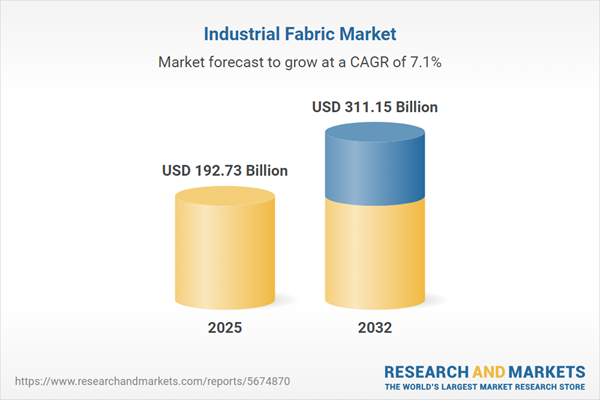Speak directly to the analyst to clarify any post sales queries you may have.
The industrial fabric market is evolving rapidly as new sustainability mandates, regulatory pressures, and advanced manufacturing technologies reshape strategic landscapes. Senior executives require insight-driven guidance and agile frameworks to lead organizations through this period of transformation.
Industrial Fabric Market Snapshot
In 2024, the industrial fabric market stands at USD 179.82 billion, with projected expansion to USD 192.73 billion by 2025 and USD 311.15 billion by 2032. This consistent growth trajectory is driven by diversified demand across sectors such as construction, transportation, healthcare, and packaging. New technical textile innovations, digital workflow integration, and advanced material development are expanding sector capabilities. These advancements equip organizations to address intricate compliance demands and deliver resilient operations in the face of evolving environmental and regulatory challenges. The global adoption of technical fabrics and process innovation underscores the sector’s ability to support long-term sustainability initiatives and operational agility on a worldwide scale.
Scope & Segmentation of the Industrial Fabric Market
This report provides senior leaders with a framework to quickly identify dominant drivers and leverage actionable strategies aligned with sector-specific needs, technology trends, and regional market dynamics.
- End Uses: Industrial fabrics play pivotal roles in agriculture for crop protection, automotive for improving interiors and safety, construction for geotextiles and insulation, filtration for contamination control, healthcare for wound care and PPE, and packaging for safeguarding goods in transit and storage.
- Fabric Types: The sector utilizes flexible knitted textiles, specialized nonwovens such as meltblown, spunbond, spunlace, and needlepunch, along with woven fabrics like plain, satin, and twill to serve a spectrum of performance needs.
- Material Types: Widely used materials include aramid, glass, nylon, polyester, and polypropylene, each offering different levels of strength, compatibility with regulatory requirements, and suitability for advanced manufacturing processes.
- Processing Techniques: Key methods include application of acrylic, polyurethane, or PVC coatings, along with calendering, heat setting, lamination, and seamless integration into workflow systems to bolster reliability and performance.
- Coating Types: Advanced surface treatments confer enhanced resistance to moisture, ultraviolet light, and abrasion, significantly extending the service life in high-stress operational environments.
- Regions Covered: In-depth insights span the Americas, Europe, Middle East and Africa, and Asia-Pacific with a focus on dynamic markets such as China, India, Japan, and Southeast Asia. Regional analysis addresses variations in supply chain structures and compliance standards.
- Prominent Companies: Key market participants include organizations like DuPont de Nemours, Royal TenCate, Freudenberg SE, Milliken & Company, Berry Global, Toray Industries, Ahlstrom-Munksjö, Kimberly-Clark, Johns Manville, and Lydall. These industry leaders are recognized for their commitment to technological development and adaptive business models.
Key Takeaways for Senior Decision-Makers
- Strategic investments are pivoting toward nanotechnology and bio-based polymers, positioning organizations to strengthen innovation pipelines and meet new sustainability targets.
- Increasing regulatory requirements and shifting trade conditions are driving organizations to enhance supply chain robustness and foster better supplier collaboration across tiers.
- Material science advancements and ongoing market research enable companies to improve product design speed and ensure readiness for fluctuating industry requirements.
- The adoption of lifecycle and circular economy practices, such as greater recycling and reuse, supports organizational transparency and advances environmental objectives.
- Expansion of digital transformation initiatives across production and logistics enhances operational efficiency and sharpens identification of market shifts using data analytics.
Tariff Impact and Supply Chain Adaptation
Recent changes in U.S. tariffs have prompted many manufacturers to localize production and elevate compliance protocols. These shifts provide greater cost stability and promote stronger business continuity. Organizations are reengineering supply chains and emphasizing proactive risk management, building resilience and adaptability in response to ongoing regulatory and price volatility in the industrial fabric market.
Methodology & Data Sources
This report uses a benchmarking approach, drawing from executive interviews, broad-based B2B market research, and expert independent reviews. The data-driven process ensures relevance for decision-makers, supporting comprehensive analysis and relevant insights for market strategy refinement.
Why This Report Matters for the Industrial Fabric Market
- Equips executives to shape innovation initiatives and prioritize investment, improving preparedness for technology transitions and changing customer requirements.
- Improves risk awareness related to regulation and international trade, strengthening the enterprise’s capability to manage diverse market exposures.
- Outlines pragmatic sustainability programs, helping organizations surpass stakeholder expectations and defend or enhance their market standing.
Conclusion
This analysis delivers actionable segmentation and future-ready insight, supporting leaders in navigating the industrial fabric sector’s evolving regulatory, sustainability, and innovation imperatives.
Additional Product Information:
- Purchase of this report includes 1 year online access with quarterly updates.
- This report can be updated on request. Please contact our Customer Experience team using the Ask a Question widget on our website.
Table of Contents
3. Executive Summary
4. Market Overview
7. Cumulative Impact of Artificial Intelligence 2025
Companies Mentioned
The companies profiled in this Industrial Fabric market report include:- DuPont de Nemours, Inc.
- Royal TenCate N.V.
- Freudenberg SE
- Milliken & Company
- Berry Global, Inc.
- Toray Industries, Inc.
- Ahlstrom-Munksjö Oyj
- Kimberly-Clark Corporation
- Johns Manville Corporation
- Lydall, Inc.
Table Information
| Report Attribute | Details |
|---|---|
| No. of Pages | 181 |
| Published | November 2025 |
| Forecast Period | 2025 - 2032 |
| Estimated Market Value ( USD | $ 192.73 Billion |
| Forecasted Market Value ( USD | $ 311.15 Billion |
| Compound Annual Growth Rate | 7.0% |
| Regions Covered | Global |
| No. of Companies Mentioned | 11 |









